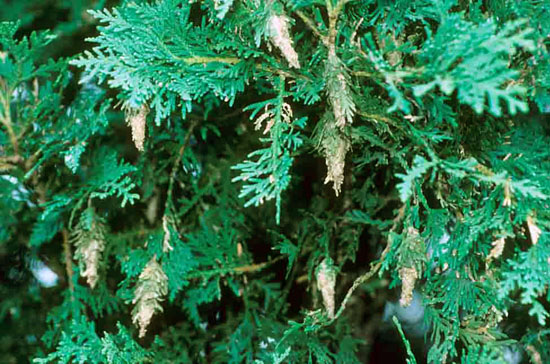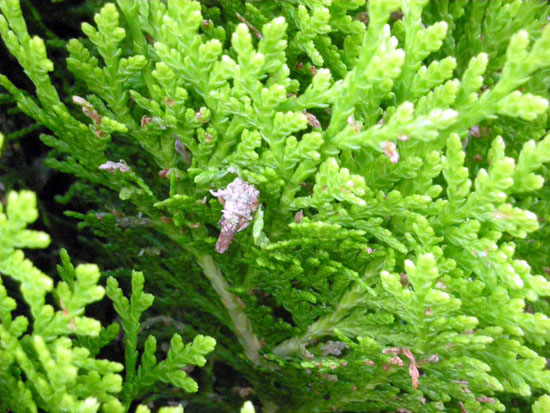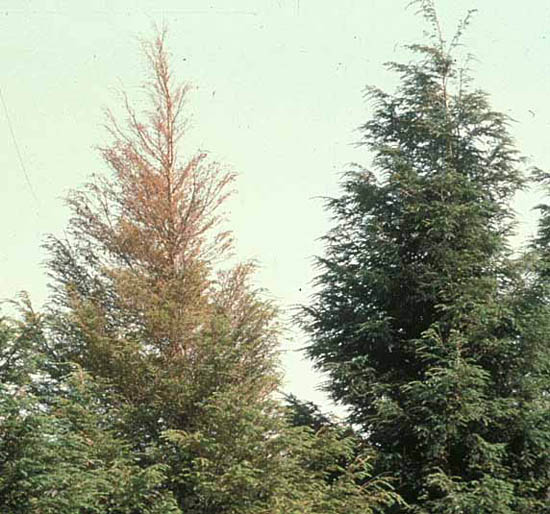Issue 7, June 12, 2017
Bagworm
It is time to treat for bagworms in southern Illinois. Bagworms are just hatching in central Illinois, and they will hatch in northern Illinois by late June. Upon hatching, young caterpillars crawl out of their mother's bag where the eggs were laid and crawl upward. They get to the top of the tree and spin out silk, creating a long streamer that catches in the wind, carrying the young bagworm to new hosts.
After a couple of weeks of doing little feeding and lots of ballooning, they settle down to feed in earnest. Bagworms are about one-quarter inch long with typical bags when they start feeding. Ballooning bagworms are smaller and either have no bags or conical ones that look somewhat like brown hats.

Bagworms feeding on arborvitae.
They feed from the top of the tree down, the result of still using that drive to climb to the top of wherever they find themselves. They prefer to feed on arborvitae, Eastern red cedar, other junipers, and spruce. They also feed on deciduous trees including crabapple, maple, and oak. Feeding on deciduous trees is less common as one moves north through Illinois, being common in southern Illinois and scarce in northern Illinois. They are by nature polyphagous, feeding on many kinds of trees and shrubs. After all, when you are blown where the wind takes you, you better eat whatever you land on.

Young bagworm on arborvitae.
Early bagworm feeding damage will appear as scarifying of the needle or leaf epidermis with internal mesophyll tissue eaten. Damaged foliage is lighter green at first and then whitish to brownish as the exposed and damaged cells die. As the bagworms get older and bigger, they eat entire leaves.

Bagworm damage to Eastern red cedar.
As long as the caterpillar is feeding, it adds silk to the top of the bags and places bits of host foliage around the top of the bag until its spindle-shaped bag reaches about one and one-half inches long. Once it has pupated or died, this practice stops and the top of the bags turn from green to brown. This is useful in scouting because pupated bagworms are not susceptible to insecticide sprays, and killed bagworms do not fall from the tree.
The bagworms feed through the summer until pupating in late summer. Pupation ranges from mid-August to very early September. Adult male bagworms are about 1/2-inch-long black moths with clear wings. Adult female bagworms are larviform; that is, they appear similar to the caterpillars. The nonfeeding males fly from bag to bag, mating with the females inside through the bottom of the bag. The nonfeeding females fill most of their bodies with eggs and die in the bag. Each female bag contains 300 to 1,000 eggs.
Because bagworm eggs overwinter in the old bags, an effective control measure on shrubs and smaller trees is to handpick the bags from September through May and destroy them. The eggs in bags dropped to the ground will hatch, and the larvae will climb the nearest upright object to balloon. Handpicking feeding larval bags is also effective.
Scout for early scarifying damage at the top of susceptible hosts. It should show up in mid-June to early July, being earlier in southern Illinois and successively later as one goes north. If you wait until ballooning ends, one insecticide application will be effective. Sprays of Bacillus thuringiensis kurstaki (Dipel, Thuricide, others) and spinosad (Conserve) are effective and selective, causing less damage to pollinators and other non-pest insects. They are also organic. Other effective insecticides include cyfluthrin (Tempo), permethrin (Astro), acetamiprid (TriStar), indoxicarb (Provaunt), and chlorantroniliprole (Acelepryn). (Phil Nixon)
Author:
Phil Nixon